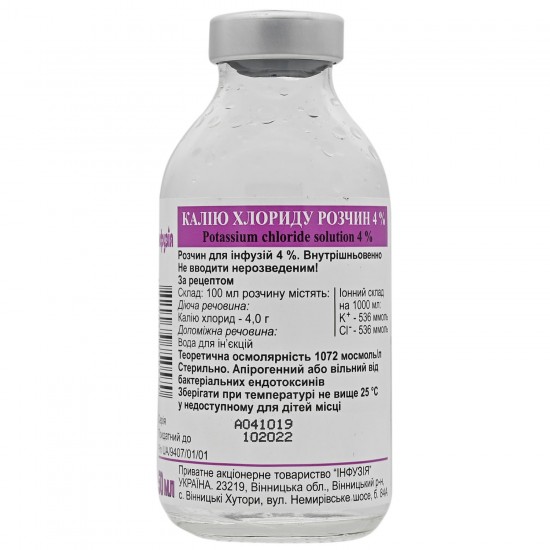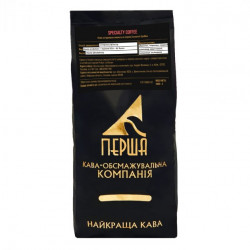



- Stock: In Stock
- Model: 176707
0% Customers recommend this product
-
5 Awesome0%
-
4 Great0%
-
3 Average0%
-
2 Bad0%
-
1 Poor0%
Reviews Over Potassium chloride solution for inf. 4% quarrystone. 100 ml
- (0)
Total Reviews (0)
click here write review to add review for this product.
Report this review.
Description
Translation of the instruction Mose
CHLORIDE POTASSIUM SOLUTION of 4% solution for infusions of 4%Instruction
On medical use of medicine
Potassium of chloride solution of 4%
(pottassium chloride solution of 4%)
Ingredients:
Active ingredient: potassium chloride;
4.0 g contain100 ml of solution potassium of chloride;
ionic structure on 1000 ml of medicine: To + — 536 mmol, Cl yu — 536 mmol;
excipient: water for injections.
Dosage form.
Solution for infusions.
Main physical and chemical properties: transparent colourless liquid, rn 4.0-7.0.
Theoretical osmolarity — 1072 mosmol/l.
Pharmacotherapeutic group.
Solutions of electrolytes. code atkh the ó05th a01.
Pharmacological properties.
Pharmacodynamics. potassium — active ingredient of medicine, is the main intracellular cation of the majority of body tissues. potassium ions are necessary for many vital physiological processes. they take part in regulation of function of excitability, contractility, conductivity and automatism of a myocardium; are necessary for maintenance of intracellular pressure, carrying out and synoptic transfer of a nervous impulse, maintenance of potassium concentration in a myocardium, skeletal muscles and smooth muscle cells and also for maintenance of normal function of kidneys. in small doses the potassium ions expand coronary vessels, in big — narrow. potassium promotes increase in maintenance of acetylcholine and excitement of sympathetic department of the central nervous system (central nervous system). has moderate diuretic action. increase in level of potassium reduces risk of development of toxic effect of cardiac glycosides on heart. potassium also plays an important role in development and correction of violations of acid-base balance.
Pharmacokinetics. Potassium is removed generally by kidneys by secretion in distal tubules where there is also a sodium-potassium exchange. The ability of kidneys to keep potassium is insignificant, and its excretion with urine continues even at considerable decrease in level of potassium in an organism. Canalicular secretion of potassium depends on several factors, including on concentration of ions of chlorine, exchange of ions of hydrogen, acid-base balance and hormones of adrenal glands. A number of potassium is distinguished with a stake, its insignificant quantity can be distinguished with saliva, then, bile or juice of a pancreas.
Clinical characteristics.
Indication.
Hypopotassemia caused by use of saluretics, pernicious vomiting, profuse diarrhea, surgical intervention; intoxication heart glucosides; the arrhythmias of various origin, including a Bouveret's disease (connected generally with electrolytic violations and an absolute or relative hypopotassemia); gipokaliyemichesky form of a paroxysmal mioplegiya; muscular dystrophy, myasthenia; decrease in level of potassium in an organism at application of corticosteroids.
Contraindication.
Disturbance of secretory function of kidneys (potassium collects in blood plasma that can lead to intoxication), violation of atrioventricular conductivity, a hyperpotassemia of various genesis, a hyperchloremia, a sharp renal failure (with oligo- or an anury, an azotemia), a retentsionny uraemic stage at chronic kidney disease, system acidosis, diabetic acidosis, sharp dehydration, considerable burns, intestinal impassability, Addison's disease, wet brain.
Medicine not to enteralong with blood preparations.
Special security measures.
Sharp cancellation "chloride potassium solution of 4%" at simultaneous application with cardiac glycosides demands extra care as the hypopotassemia which at the same time develops enhances toxicity of a foxglove.
not to enternot divorced!
Interaction with other medicines and other types of interactions.
At simultaneous use of potassium of chloride with kaliysberegayushchy diuretics, inhibitors of angiotensin-converting enzyme (apf), Trimethoprimum and non-steroidal anti-inflammatory medicaments (npvs) risk of development of a hyperpotassemia increases (it is necessary to control potassium level in blood serum). under the influence of medicines of potassium the side effect of cardiac glycosides decreases, effect of quinidine on heart and also undesirable effect of Disopyramidum on a cardiovascular system amplifies.
Feature of application.
recommends to controlduring treatment regularly potassium level in blood serum and also acid-base balance of blood, to carry out monitoring of warm activity by means of the ECG, especially at patients with diseases of a cardiovascular system and kidneys.
needs to treat also a lack of magnesium which can accompany a lack of potassium.
At patients with chronic diseases of kidneys or with any diseases which are followed by violation of removal of potassium from an organism or at too fast intravenous administration "Chloride potassium solution of 4%" development of a hyperpotassemia which can potentially lead to a lethal outcome is possible.
to applyWith care at diseases of a cardiovascular system, at simultaneous application with kaliysberegayushchy diuretics.
Simultaneous parenteral application of calcium ions can cause arrhythmia.
Use during pregnancy or feeding by a breast.
Medicine can be applied byaccording to vital indications if the advantage prevails over risk. it is necessary to take in attention that medicines of potassium reduce a uterus tone.
Ability to influence speed of response at control of motor transport or other mechanisms.
should use Drug only in the conditions of a hospital. the influences of medicine on speed of response given relatively at control of motor transport or work with other mechanisms are absent.
Route of administration and doses.
to Applyintravenously by drop infusion. the necessary dose should be determined by indicators of content of potassium in blood serum. potassium to calculate deficiency by a formula:
Potassium = body weight × 0.2 × 2 × (4.5 — To + plasmas y );
where: potassium — calculation in mmol, body weight — calculation in kg, 4.5 — the normal level of potassium of mmol/l in blood serum, To + plasmas y — the actual content of potassium (mmol/l) in blood serum of the patient.
Received result is a necessary quantity for an organism (deficiency) of potassium in mmol. For determination of amount of medicine which needs to be used it is necessary to consider that "Chloride potassium solution of 4%" contains ions To + — 0.536 mmol/ml. The necessary amount of solution should be parted with water for injections by 10 times (up to 500 ml) and to enter by drop infusion (20–30 drops a minute). Also as solvent it is possible to use 0.9% solution of sodium of chloride or 5% glucose solution.
In the heavy intoxications demanding fast elimination of the pathological phenomena should apply "Chloride potassium solution of 4%", divorced in 40% glucose solution.
Usual recommended dose should not exceed 20 mmol of potassium an hour or 2–3 mmol of potassium on kilogram of body weight within a day.
In case of emergency when potassium level in blood serum is less than 2 mmol/l or the threat of a hypopotassemia (potassium level in blood serum of less than 2 mmol/l, or changes on the ECG and/or paralysis of muscles are noticed) exists, the dose should be selected individually (the dose can make up to 40 mg/h or 400 mg/days), at the same time observation of the doctor, monitoring of warm activity by means of the ECG, frequent check of level of potassium in blood serum for the purpose of prevention of a hyperpotassemia and cardiac arrest is necessary.
Children.
Data on use of medicine to children are absent.
Overdose.
Long time remains toasymptomatic until potassium concentration in blood serum reaches the high level (6.5-8 mmol/l). development of a hyperpotassemia and an overhydratation is possible. at the same time at patients muscle weakness, an abdominal pain, paresthesias, frequent shallow breathing, arrhythmia is observed, the loss of consciousness, fervescence, apathy, a lowering of arterial pressure and body weights, mental disorders is possible. on the electrocardiogram the t tooth point, a st segment depression, expansion of the qrs complex, reduction of amplitude of a tooth r, lengthening of an interval of pq is registered. in this case medicine needs to be cancelled.
symptomatic treatment directed to maintenance of the vital functions. To parenterally administer the medicaments of usual insulin and medicines of calcium. In hard cases carrying out a hemodialysis is shown.
Side reactions.
Disturbance of electrolytic balance: hypophosphatemia; hypomagnesiemia; hyperpotassemia; hyponatremia.
from a digestive tract: dispepsichesky frustration (nausea, abdominal pain).
from a cardiovascular system: bradycardia; cardiac conduction abnormality, arrhythmia, premature ventricular contraction; arterial hypotension.
from the immune system: allergic reactions (hyperthermia, skin rash, Quincke's disease, shock).
from nervous system: in isolated cases at application of high doses there can be a weakness, paresthesia, confusion of consciousness.
General reactions of an organism: hypervolemia; suffocation; sore throat.
Change in the injection site: pain, reddening, phlebitis.
in case of side reactions introduction of solution should be stopped.
Therapy — symptomatic.
Expiration date.
3 years.
Storage conditions.
to Storeat a temperature not above 25 °C out of children's reach.
Incompatibility.
not to mixwith other medicines. as solvent not to use other medicines, except specified in the section "route of administration and doses".
Packing.
On 50 ml or on 100 ml in bottles.
Category of a holiday.
According to the prescription.
Producer.
Private joint-stock company "infuziya".
Location of the producer and address of the place of implementation of its activity.
Ukraine, 23219, Vinnytsia Region, Vinnytsia district, page Vinnytsia farm, st. nemirovsky highway, 84a.
Specifications
| Characteristics | |
| Active ingredients | Potassium chloride |
| Amount of active ingredient | 40 mg/ml |
| Applicant | Infusion |
| Code of automatic telephone exchange | B05XA01 Potassium chloride |
| Interaction with food | It doesn't matter |
| Light sensitivity | Not sensitive |
| Market status | Traditional |
| Origin | Chemical |
| Prescription status | According to the prescription |
| Primary packing | bottle |
| Producer | INFUSION CIAO |
| Quantity in packing | 100 ml |
| Release form | solution for infusions |
| Route of administration | Infusional |
| Sign | Domestic |
| Storage temperature | from 5 °C to 25 °C |
| Trade name | Potassium chloride |







































